Types of Florida Hornets and Wasps (With Pictures) – Identification Guide

Wasps are a common occurrence in Florida during most times of the year. The most common wasps you will find in the Sunshine State are yellowjackets. However, species of paper wasps, potter wasps, mud daubers, and huge hornets are also common in the southeastern US from spring until late fall.
Florida’s unique climate allows wasps to thrive in garden landscapes throughout the year. Although only a few species of wasps are aggressive, they will vigorously defend themselves or their nests when provoked. Therefore, it’s a good idea to know how to identify species of wasps if you live in Florida.
This article is an identification guide to common Florida wasps. Descriptions of the wasp’s appearance and pictures of the stinging flying insects will help you recognize various species of native wasps.
How to Identify Wasps in Florida
Wasp identification in Florida is made by looking at the insect’s body shape, size, and coloration. Many wasps are yellow and black with stripes. However, some wasps don’t have identifiable markings. All types of wasps have a three-segmented body — a head and thorax joined by a thin waist to its abdomen.
Wasps vs. Hornets
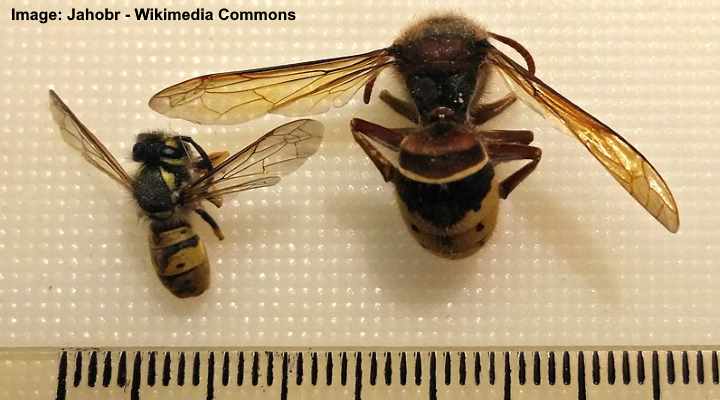
Size comparison of wasp (left) and hornet (right)
The difference between hornets and wasps is their size. All species of hornets are large wasps that can measure over 1” (25 mm) long. Wasps, on the other hand, are smaller, with slender bodies and typically measure between 0.4” and 1” (10 – 25 mm).
Regarding aggressiveness, there is little difference between wasps and hornets in Florida. Like hornets, many social wasps have stingers and aggressively defend their nests. Therefore, their aggressive defensive nature can be a problem in gardens if you get too close to a nest or try to remove an inhabited papery nest.
Types of Florida Hornets (With Pictures) – Identification Guide
Hornets are some of the largest wasps you will encounter in Florida. The two most common hornets in the southeast are the European hornet and the bald-faced hornet. Let’s look in detail at the identification features of these pesky flying insects.
Bald-Faced Hornet (Dolichovespula maculata)
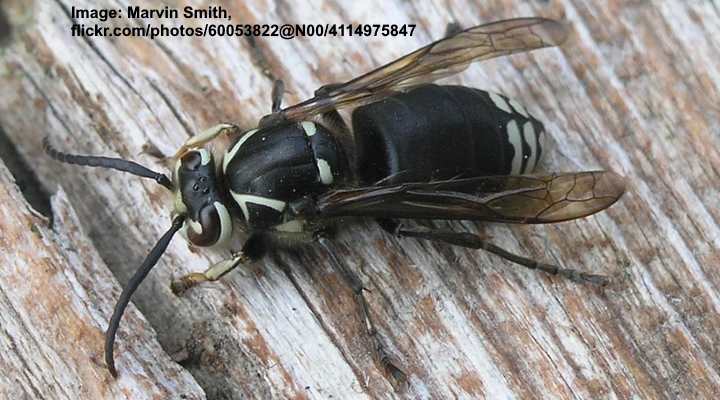
The large bald-faced hornet is mostly black with few white markings
The bald-faced hornet is an easily recognizable black wasp in Florida because of its black-and-white coloration. The large wasp has a jet-black body with three creamy-white stripes at its tail end. It also has two whitish V-shapes and two spots on its thorax. An identifiable feature is its C-shaped compound eyes.
Despite being called a hornet, this black and white wasp is a yellowjacket species. The wasp grows 0.8” to 1” (20 – 25 mm) long, making it a similar size to true hornets. The females also have stingers and can inflict a painful sting when annoyed.
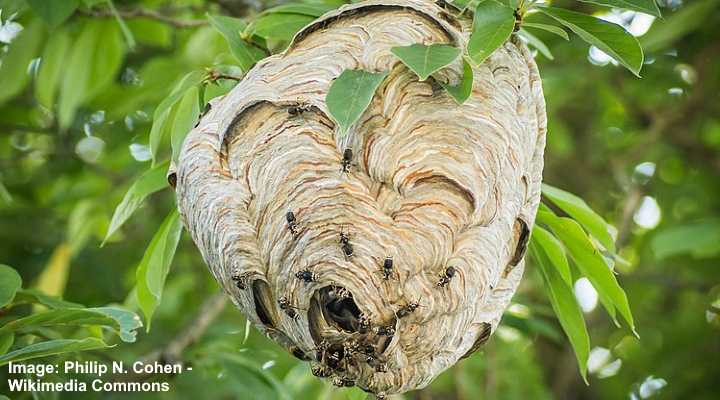
bald-faced hornet nest
European Hornet (Vespa crabro)

The large European hornet has black and red thorax and its abdomen is mostly black and yellow
The European hornet is a sizable wasp with dark reddish-brown and yellow markings. The large hornet has yellow bands with black spots on its abdomen. It is identified by its black and red thorax, flattened, triangular reddish face, and orange-red antennae and legs. You’ll also notice blackish bands at the top of the abdomen.
The European hornet is one of the largest wasps in Florida. The robust wasps measure 1” (25 mm) long, with the females growing up to 1.4” (35 mm). They’re not as aggressive as the Asian giant hornet, but they have stingers. And they can attack in groups, giving multiple stings when provoked.
These stinging pests can be dangerous to people who have allergies to bee stings.
If you notice a large black, yellow and reddish wasp making a loud buzzing sound, the chances are that it’s a European hornet. This species of giant hornet is the only true hornet found in Florida.
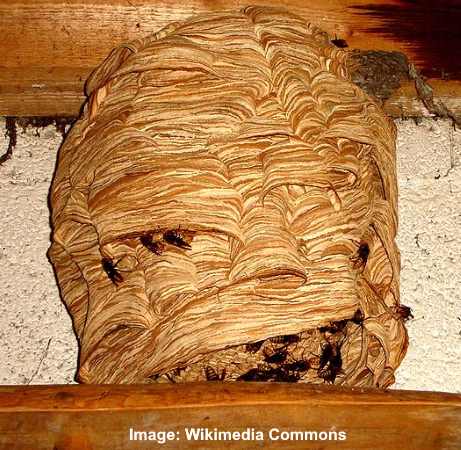
Vespa crabro nest
Types of Florida Wasps (With Pictures) – Identification Guide
There are many types of wasps found in Florida. These include yellow jackets, paper wasps, potter wasps, and cicada killer wasps. All these different species have their own unique characteristics, making it possible to identify them.
Southern Yellowjacket (Vespula squamosa)

The black and yellow striped southern yellowjacket is a common wasp in Florida
The southern yellowjacket is one of the most common black and yellow wasps you will find in Florida. The large social wasp has vibrant yellow and black patterning with horizontal yellow stripes on its abdomen and vertical stripes on its thorax. In addition, the wasps have black antennae, clear amber wings, and yellow legs.
The southern yellowjacket measures 0.5” (13 mm) and has an easily recognizable black body with bright yellow stripes. A difference between these yellowjackets and other species is the queen’s coloration. The queen wasp is significantly larger and has orange stripes, not yellow.
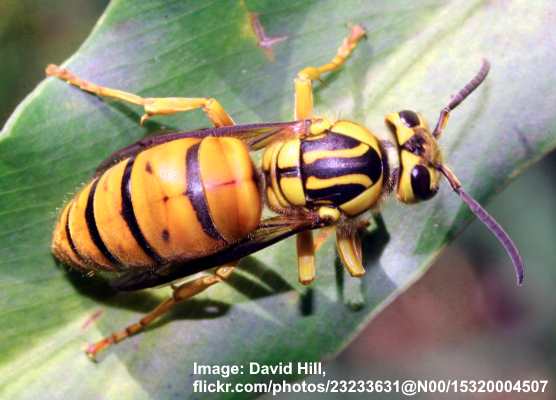
Southern yellowjacket queen
Southern yellowjackets are a common type of wasp in the southeastern United States and are active during warm weather.
Eastern Yellowjacket (Vespula maculifrons)
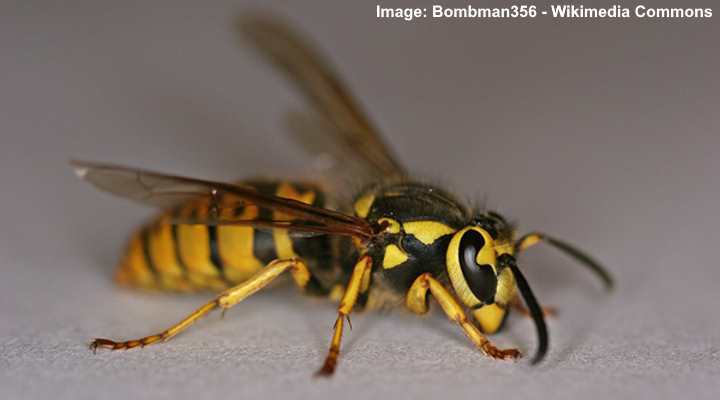
The black and yellow eastern yellowjacket is relatively small and lives in papery cone-like nests
The eastern yellowjacket is a smaller species of black and yellow wasp common in Florida. The wasp has characteristic black and yellow lines on its abdomen. However, unlike the southern yellowjacket, there are no yellow lines on its thorax, only a black diamond marking. In addition, there are two large black compound eyes on its triangular yellow face.
The eastern yellowjacket measures 0.5” to 0.62” (13 – 16 mm) long. These social wasps live in large tan-brown or orange papery nests up to 12” (300 mm) in diameter. These cone-like structures can contain thousands of worker wasps. The yellowjacket nests can be underground or in wall voids.
Red Paper Wasps (Polistes carolina and Polistes rubiginosus)
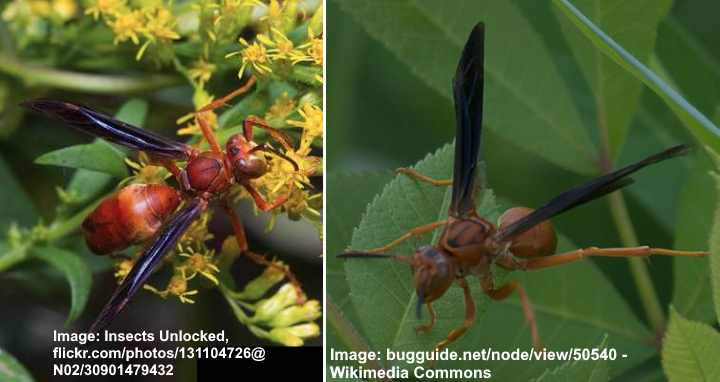
Red paper wasps: Polistes carolina (left) and Polistes rubiginosus (right)
There are two species of red paper wasps commonly found in Florida. The red-colored wasp has a slender, elongated body, oval thorax, and small head. One of the most distinguishing features is the black wings on these red wasps. Like most wasp species, they don’t have an aggressive nature but will sting if provoked.
Red paper wasp nests are unusual because they have an upside-down umbrella shape. The nest consists of several hexagonal tubes with open ends. You often find paper wasp nests dangling from tree branches, patio ceilings, or shrubs.
These two species of reddish-brown wasps measure 1” to 1.26” (25 – 32 mm) long. Unlike many species of brown paper wasps, these stinging wasps don’t have any stripes or identifiable markings. However, they are the only species of red-colored wasps in Florida.
New World Paper Wasp (Mischocyttarus mexicanus)
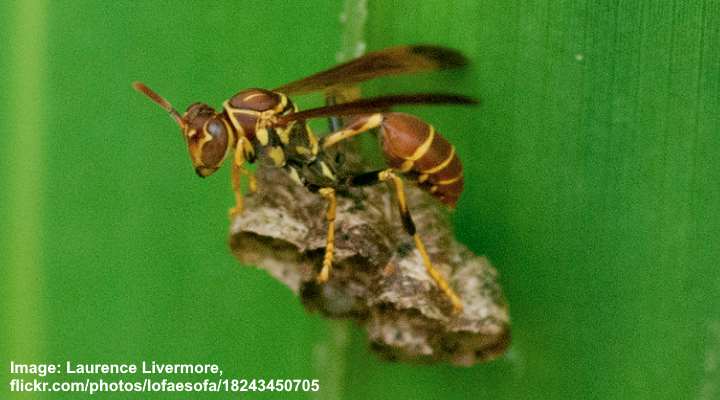
The small new world paper wasp is a brown wasp with yellow markings and very slim and long waist
New world paper wasps are small yellow-striped brown wasps commonly found in Florida and southern states. The paper wasp has an oval abdomen, thin, elongated waist, and humped thorax. Other identifying features are its yellow and black banded legs and stumpy antennae that are a brown color.
This type of wasp measures 0.43 to 0.59” (11 – 15 mm) long. Classed as a long-waisted paper wasp, this species has a notable slender body thanks to its long waist section.
A subspecies of Mischocyttarus mexicanus cubicola is only found in central and south Florida and sometimes in Texas.
Cicada Killer Wasps (Sphecius speciosus)
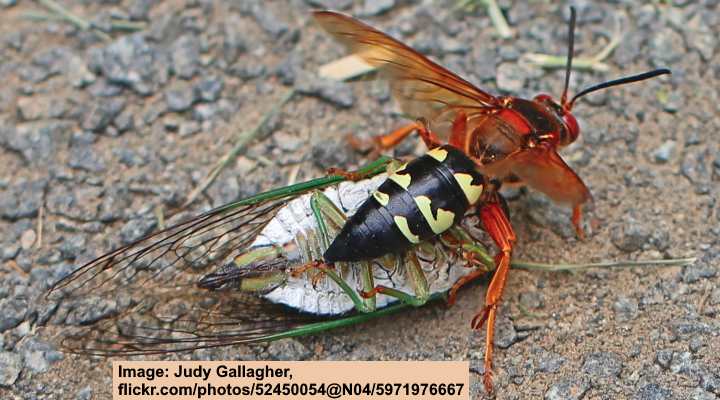
A picture of Eastern cicada killer (Sphecius speciosus) with a cicada
The cicada killer wasp is a common Florida species with unique colorful patterns. This large wasp is identified by its black abdomen with pale yellow markings, red and black thorax, red wings, and legs. The predatory wasp grows 1.4” (35 mm) long and preys on cicadas and other insects.
Cicada killer wasp nests are located underground and consist of an extensive tunnel system. These underground nests can be so large that they can destroy lawns or make patio paving uneven.
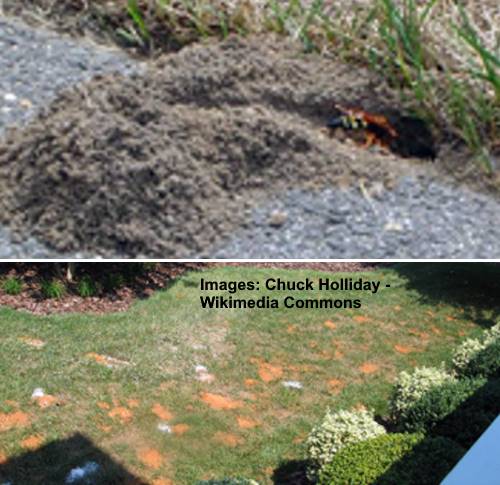
Top image: A female cicada killer wasp digging a burrow next to a driveway. Bottom image: Cicada killer infestation in a yard; the reddish brown patches are cicada killer burrows
Due to their large size, cicada killer wasps are also called cicada hawks or sand hornets. These wasps have a reputation for being aggressive. However, it’s typically the stingless male wasps that menacingly hover around people. Female cicada killer wasps tend to leave people alone.
Black and Yellow Mud Dauber Wasp (Sceliphron caementarium)

The black-and-yellow mud dauber wasp can be identified by its very slim and elongated waist
The black and yellow mud dauber is a solitary wasp identified by its sleek, slender body, thread-thin waist, and yellow and black colors. Compared to other Florida wasps, these harmless wasps have long legs. A distinguishing feature of this wasp species is its yellow markings on the hind legs.
The spider-hunting mud dauber wasp measures 1” to 1.1” (24 – 28 mm) long. Mud daubers get their name from the nest they create out of mud. You can find the nests under eaves, roof overhangs, rafters, and porch ceilings.
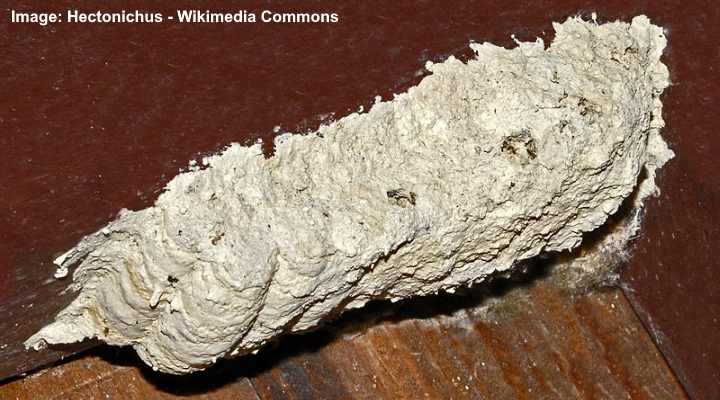
Sceliphron caementarium nest
Apart from the yellow-legged mud dauber wasp, other similar species common to Florida are the blue mud wasp (Chalybion californicum) and organ pipe mud dauber (Trypoxylon politum). Florida’s warm, humid climate means these unusual wasps thrive.
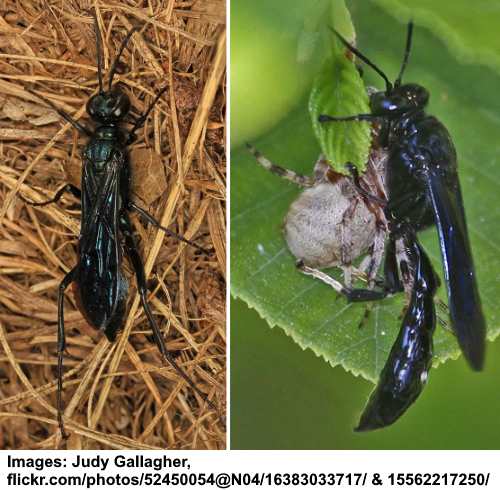
The blue mud wasp (left) and the pipe organ mud dauber with a spider (right)
Eastern Velvet Ant Wasp (Dasymutilla occidentalis)
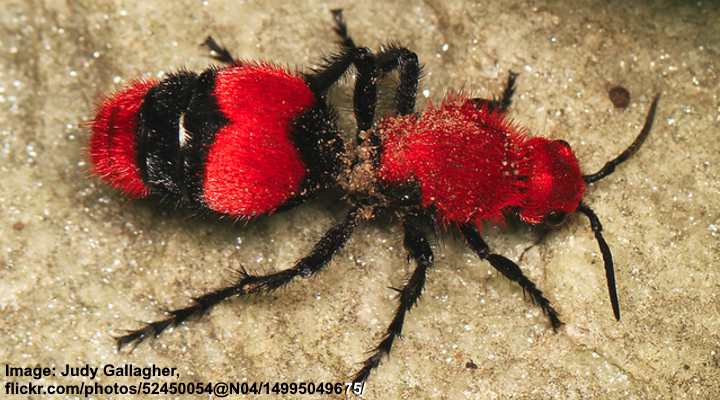
The eastern velvet ant is a parasitic wasp that can be easily identified by its black and red coloration and furry body
A wasp that looks like an ant is the eastern velvet ant wasp. This parasitic wasp has distinctive red coloring with a black band across the abdomen. The striking wasp has a furry red thorax, black, spiny legs, and two black eyes on the side of its head.
Also called the cow killer, red velvet ant, or cow ant, this furry wasp is a stinging insect common to all parts of Florida. It measures 0.75” (19 mm) long. Female wasps can inflict terrible stings that can cause allergic reactions in some people.
Fraternal Potter Wasp (Eumenes fraternus)
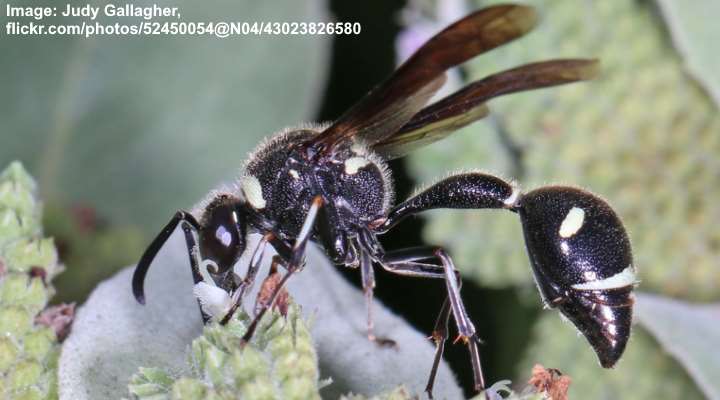
Fraternal potter wasps are mainly black with a few creamy-white markings
This species of potter wasp is the only type of potter wasp you will find in Florida. The black wasp is identified by its large bulbous abdomen attached by a thin tail to the body. In addition, the wasp has ivory-white markings on all three parts of its fuzzy body.
This Florida potter wasp grows 0.51” to 0.67” (13 – 17 mm) long. Its name comes from the wasp’s habit of creating jug-like nests from mud. These small structures are found on window sills, picnic tables, shrubs, and buildings.
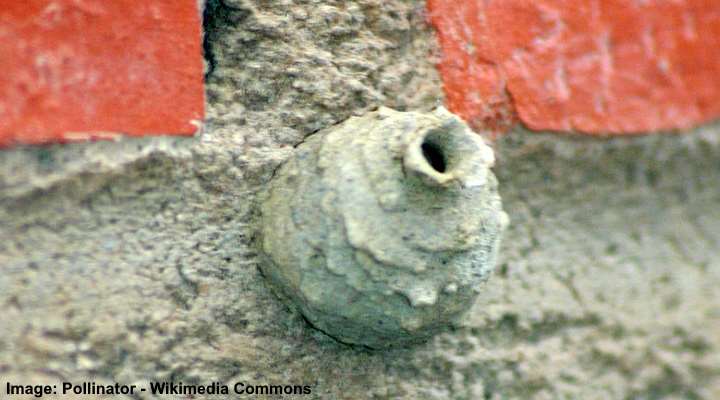
Potter wasp nest
Four-Spotted Scoliid Wasp (Pygodasis quadrimaculata)
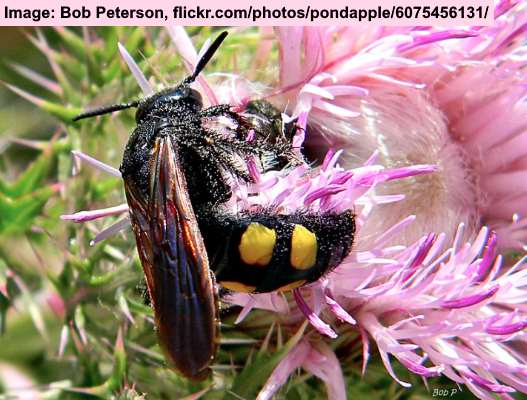
The four-spotted scoliid wasp has 2 pairs of yellow or orange spots on its back
The four-spotted scoliid wasp is a large black wasp with two pairs of spots on its back. These prominent, colorful orange or yellow markings stand out against the jet-black body. The major difference between the female and male species is color. The females typically have orange, not yellow spots.
Four-spotted scoliid wasps are active in Florida in spring and summer. Additionally, you can see the yellow-spotted black wasps feed on nectar from flowers.
The large black Florida wasps measure between 0.59” and 1.37” (15 – 35 mm). A difference between male and female four-spotted scoliid wasps is the abdominal patterns. The males tend to have yellowish bands, not individual spots.
Noble Scoliid Wasp (Scolia nobilitata)
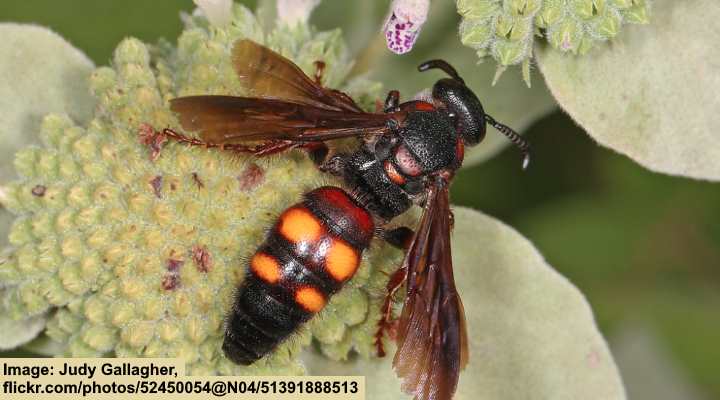
The noble scoliid wasp has black, orange-yellow and red colors and is common in Florida
The noble scoliid wasp is a stout-bodied wasp with vibrant red, white, and yellow-orange colors on a black body. These beautiful wasps are common in Florida and measure 0.39” to 0.59” (10 – 15 mm) long. The identifying features are the small red spot on its thorax and large abdominal orange or yellow spots.
Mole Cricket Hunter Wasp (Larra bicolor)

The mole cricket hunter wasp has a black slender body with reddish brown abdomen
The Larra bicolor wasp is a black stinging insect with an identifiable reddish-brown abdomen. The slender black wasp has silvery markings on its head, brown to indigo-blue wings, and spiny black legs. Typically mole cricket hunters measure up to 0.86” (22 mm) long.
These black wasps were introduced to Florida to control the spread of mole crickets. You often see them feeding on flower nectar in Florida gardens from early May through late December. They tend to feed on flowers like goldenrod, boneset, anise, and false buttonweed.
Harmless to humans, the black and brown wasps sting their prey to lay parasitic eggs.
Ringed Paper Wasp (Polistes annularis)
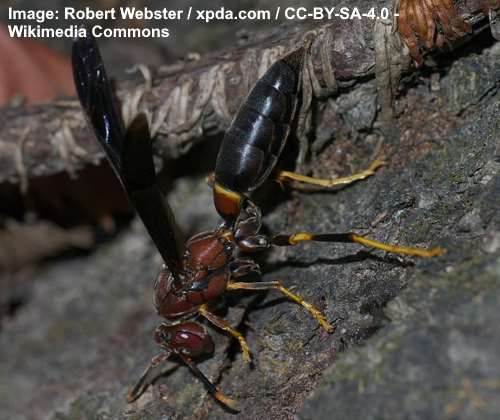
The ringed paper wasp has reddish-brown head and thorax, black abdomen and wings, and yellow legs
Also called the jack Spaniard wasp, this large red wasp has a recognizable reddish-brown and black coloration. Common throughout Florida, the paper wasp species has a reddish-brown head and thorax, oval black abdomen, and yellow legs. It also has the unusual feature of slender black wings.
The ringed paper wasp gets its name from the yellow band around the top of the abdomen. It also has black markings on the rusty brown thorax. However, these markings depend on the climate, with wasps in south Florida appearing darker.
The black and red paper wasps measure between 0.7” and 0.9” (17 – 24 mm) long. They also have slender wings of a similar length.
Great Golden Digger Wasp (Sphex ichneumoneus)
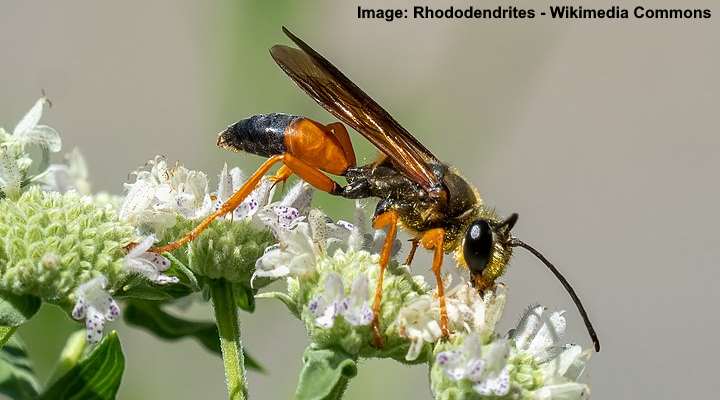
The large black and orange great golden digger wasp has big compound eyes with long antennae
The great golden digger wasp is often found in southeastern gardens during summer. This colorful wasp has several features making it easy to identify. It has a black and orange abdomen, legs, and deep orange wings. Additionally, there is a yellow stripe on its brown thorax.
Looking at pictures of this common Florida wasp, you’ll also notice its huge compound eyes on either side of its head. Additionally, the multi-colored wasp has large black antennae. Despite being a stinging wasp, it is not considered an aggressive species.
This large solitary wasp grows around 1.5” (38 mm) long. The black and orange skinny wasps feed on flower nectar, crickets, and katydids.
Four-Toothed Mason Wasp (Monobia quadridens)
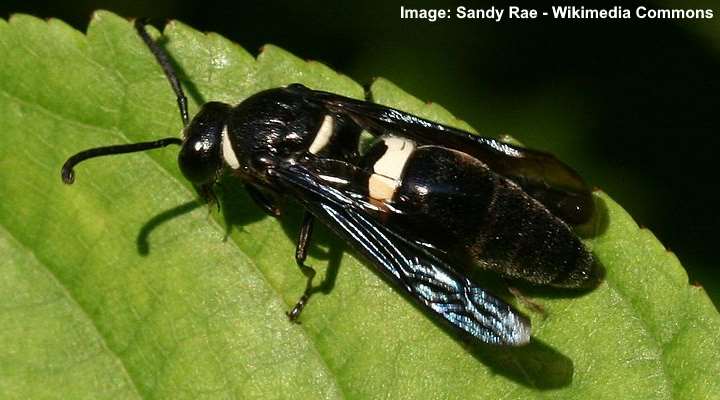
The black four-toothed mason wasp has creamy white band on the top abdomen
The four-toothed mason wasp is a common wasp found throughout Florida. This black wasp is easily identified by its white band across the top of its abdomen and white markings on its black thorax. The solitary mason wasp is a parasitoid insect that kills and feeds on caterpillars.
The white-striped black wasp measures about 0.7” (18 mm) long. It is easy to recognize due to its shiny jet-black body with an ivory band near its waist.
Red and Black Mason Wasp (Pachodynerus erynnis)
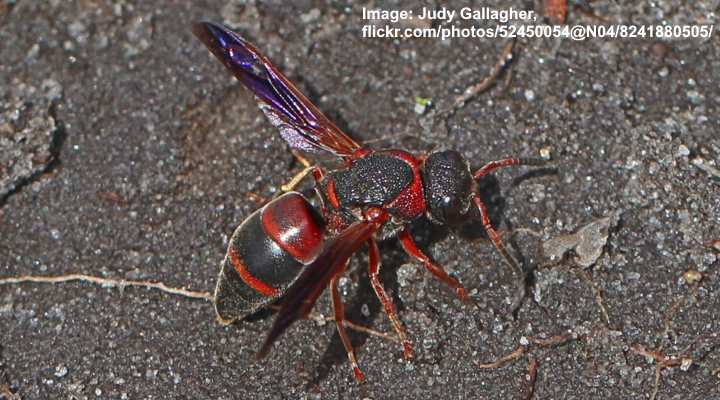
The small red and black mason wasp is common in Florida and southeastern US
The red and black mason wasp is another wasp common in the southeastern US. This small solitary wasp is easily identifiable by its black and dull rusty-red bands around its abdomen. Its thorax is black with a bright red horseshoe shape and black-tipped red antennae on a black head.
This stinging wasp is common from South Florida north to the Carolinas. The adult wasps measure 0.28” to 0.55” (7 – 14 mm) long. As with all mason wasps, they build nests in dry soil or sand, creating long tunnels where the female wasps lay eggs.
The red and black mason wasp is a beneficial type of insect because it is an important pollinator. Additionally, it feeds on white grubs and caterpillar pests like cutworms, loopers, and armyworms.
Related articles:
